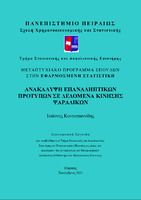Ανακάλυψη επαναληπτικών προτύπων σε δεδομένα κίνησης ψαράδικων
Periodic pattern discovery in fishery vessels

Προβολή/
Περίληψη
Στην σύγχρονη εποχή όπου υπάρχει ένας τεράστιος όγκος πληροφοριών η αξιοποίηση αυτών αποτελεί ένα σημαντικό κομμάτι μελέτης. Ένας τρόπος για να αξιοποιήσουμε τις πληροφορίες αυτές και να καταλήξουμε σε χρήσιμα συμπεράσματα είναι με το να εντοπίσουμε κάποια μοτίβα μέσα από τα δεδομένα μας. Τι είναι μοτίβα? Με μία γρήγορη ερμηνεία του όρου αυτού θα μπορούσαμε να πούμε πως είναι ένα επαναλαμβανόμενο δομοστοιχείο. Ο εντοπισμός μοτίβων μπορεί να χρησιμοποιηθεί σε μία τεράστια γκάμα διαφορετικών τύπου δεδομένων, για παράδειγμα θα μπορούσαμε να εντοπίσουμε κάποια μοτίβα σε συμπεριφορές ζώων, σε συμπεριφορές καταναλωτών, στην μετεωρολογία και σε πολλά άλλα. Η συγκεκριμένη διπλωματική αναφέρετε στον εντοπισμό μοτίβων σε δεδομένα κίνησης ψαράδικων. Σκοπός της παρούσας εργασίας είναι μέσα από τα δεδομένα να μπορέσουν να αντληθούν κάποιες περιοδικές συμπεριφορές που παρουσιάζουν τα ψαράδικα και αργότερα να διαπιστωθεί εάν μπορούμε να βγάλουμε κάποια χρήσιμα συμπεράσματα από αυτά. Τα δεδομένα που χρησιμοποιήθηκαν είναι τύπου AIS και VMS τα οποία αναφέρονται σε δύο διαφορετικούς τύπους παρακολούθησης και καταγραφής των δεδομένων των σκαφών.
Στη συγκεκριμένη διπλωματική εργασία αναφέρονται δύο διαφορετικού τύποι δεδομένα που θα μπορούσαν να χρησιμοποιηθούν για τον εντοπισμό μοτίβων κινούμενων αντικειμένων. Ο πρώτος τύπος δεδομένων αναφέρεται σε σειριακές ακολουθίες, δηλαδή δισδιάστατα δεδομένα όπου έχουμε πληροφορία για το γεωγραφικό πλάτος και μήκος της εγγραφής. Ο δεύτερος τύπος δεδομένων που αναφέρθηκε είναι χωροχρονικά δεδομένα, δηλαδή τρισδιάστατα δεδομένα όπου στο γεωγραφικό πλάτος και μήκος προστίθεται και ο χρόνος της εγγραφής. Μαζί με τους τύπους των δεδομένων έγινε και η περιγραφή κάποιων αλγορίθμων που μπορούν να χρησιμοποιηθούν για τον εντοπισμό των μοτίβων ανάλογα με τον τύπο των δεδομένων.
Τέλος έγινε μία ανάλυση βασισμένη στον αλγόριθμο Periodica για τον εντοπισμό των περιοδικών συμπεριφορών στα δεδομένα κίνησης των ψαράδικων. Αρχικά καθαρίστηκαν τα δεδομένα μας, εντοπίστηκαν ποια από αυτά μπορούν να χρησιμοποιηθούν για ανάλυση μία φορά για τα AIS δεδομένα και μία για τα VMS. Στη συνέχεια έγινε μία μετατροπή των δεδομένων έτσι ώστε οι εγγραφές κάθε αλιευτικού σκάφους κατάλληλου για ανάλυση να αποτελείται από δεδομένα με σταθερό χρονικό βήμα. Τέλος βγήκαν κάποια από κοινού συμπεράσματα.
Για τον καθαρισμό των δεδομένων χρησιμοποιήθηκε η γλώσσα προγραμματισμού R και για την μετατροπή των δεδομένων η γλώσσα matlab. Επίσης ο αλγόριθμος Periodica ήταν σε γλώσσα matlab.


